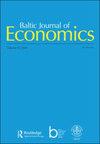Gender wage gap in Estonia: a non-parametric decomposition
IF 0.8
3区 经济学
Q3 ECONOMICS
引用次数: 13
Abstract
Estonia has the highest gender wage gap in the European Union and the highest degree of gender segregation by occupation and industry. Previous studies have found that most of the gap remains unexplained by personal and job characteristics. However, key job characteristics, occupation and industry, are usually imprecisely measured, leading to the question of whether all relevant characteristics have been properly taken into account in the decompositions. In this paper, we perform the decomposition of the wage gap to see how much of the wage gap remains unexplained after using more detailed data than has been common in previous studies (the Estonian Structure of Earnings Study data set), and discuss the related methodological challenges. Using a non-parametric method that takes into account differences in supports of distributions of male and female workers’ characteristics, we find that using more detailed data does not eliminate the unexplained wage gap: about half of the wage gap remains unexplained even using the full set of available variables.爱沙尼亚性别工资差距:非参数分解
爱沙尼亚的性别工资差距在欧洲联盟中是最大的,按职业和行业划分的性别隔离程度也是最高的。先前的研究发现,大部分差距仍然无法用个人和工作特征来解释。然而,关键的工作特征,职业和行业,通常是不精确测量的,导致在分解中是否适当考虑到所有有关特征的问题。在本文中,我们对工资差距进行了分解,看看在使用比以前的研究(爱沙尼亚收入结构研究数据集)更详细的数据后,有多少工资差距仍然无法解释,并讨论了相关的方法挑战。使用非参数方法,考虑到男女工人特征分布的支持度差异,我们发现使用更详细的数据并不能消除无法解释的工资差距:即使使用完整的可用变量集,大约一半的工资差距仍然无法解释。
本文章由计算机程序翻译,如有差异,请以英文原文为准。
求助全文
约1分钟内获得全文
求助全文

 求助内容:
求助内容: 应助结果提醒方式:
应助结果提醒方式:


